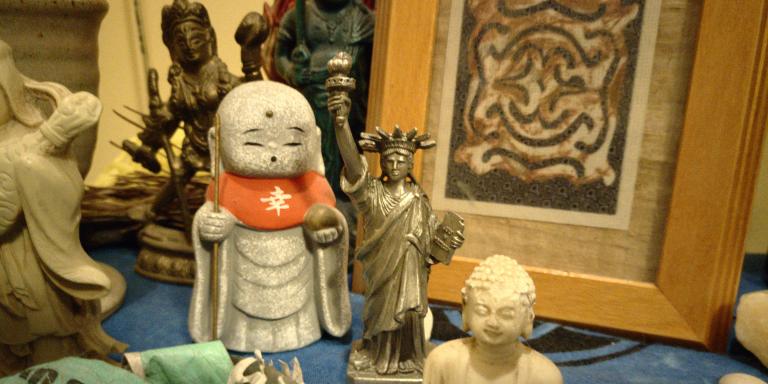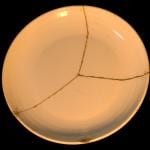Where do gods come from?
In whatever sense we might say that the gods exist (a question that depends on the ontological stance we take), either their existence is independent of that of humans and we merely discover them; or their existence is in some way dependent on us, we create them or the co-arise with us.
Whether they are discovered or created, the process often starts with impressions and images (along the general lines of “totems”, in the Durkheimian sense of that word) rather than stories or dogma. Images can be more accessible, and different images don’t directly contradict each other the way different stories do. We can resolve two very different images more easily than we can resolve contradictory stories.
Creating anthropomorphic or zoomorphic images of a larger-than-life being who embodies abstract aspects of our human experience may often be the first step to discovering or creating a god.
And it doesn’t take long to get going with it — according to the Old Testament, it only took forty days for the ancient Israelites to whip up a god-statue of a golden calf. (And to be murdered for it by zealot Jehovah-worshipers.)
But what’s interesting is that we still create these sort of images today.
In fact two of them reside on my altar, next to ancient gods and spirits and heroes. Along with Pan and Kali, Fudō Myō-ō/Acala and the Buddha, Benzaiten/Sarasvati and Hotei, you will find on my altar Lady Liberty, the American goddess whose Statue stands in New York Harbor, and Sento-kun, a Japanese genius loci of the city of Nara, of recent creation but ancient roots.
Sento-kun is a very interesting example of a Horned God, with roots in the role of deer as messengers of the kami in Shinto, but also in the cartoonish nature of mascots. We may return to him another time.
For the moment I’d like to focus on Lady Liberty, the newest addition to my altar. I visited Liberty Island while I was in New York recently, and it seemed meet to pick up a figurine at the gift shop (had to look a bit to find one made the US) to let her take her place besides other deities whose domains (physical or spiritual) I have visited.
I think I first encountered the idea of Lady Liberty as a deity in the 1980s, in a piece in Poul Anderson’s collection Fantasy titled “Bullwinch’s Mythology”, a satirical look at the “twentieth century American pantheon”. Then sometime in the 1990s I read an issue of Neil Gaiman’s Sandman where she is mentioned, along with King Kong and Marilyn Monroe, as part of a group of “later gods, new altars and icons.” The idea has stuck with me since then.
Of course the Statue of Liberty was heavily influenced by the Roman Libertas, but she has distinct properties — some present at the statue’s creation, some developed in the years after. The idea of “Liberty Enlightening the World” (her full name) is one from the post-Enlightenment modern West, not ancient Rome. In fact it came from an earlier idea her sculptor, Frédéric Auguste Bartholdi, had for a lighthouse on the Suez Canal to be built in the form of an statue of an ancient Egyptian woman; the proposed statue was to be called “Egypt Carrying the Light to Asia”.
Bartholdi did not have immigration or the idea of the “Mother of Exiles” in mind. The famous Emma Lazarus poem was written for one of many fundraisers for the statue’s pedestal. It was not part of the official building or unveiling of the statue at all; only after the poet’s death did friends of hers begin a campaign to immortalize her through the poem, and a plaque with words from the sonnet was placed on the inner wall of the pedestal in 1903.
(On a side note, Lazarus dedicated an early collection of her poems to her friend Ralph Waldo Emerson, whose influence on Paganism I discuss in Why Buddha Touched The Earth.)
But history has always shown the gods to evolve over the course of their existence. Athena, goddess of democracy, started off as a Minoan-Mycenaean palace goddess. Or contrast the Jehovah of the Old and New Testaments.
Lady Liberty entered human minds in relation to the ideals of (small-r) republican governance and the abolition of slavery, but her geographical position — influenced by Bartholdi’s old idea of a lighthouse — made her America’s greeter for those arriving at Ellis Island.
But with fewer immigrants arriving by boat, perhaps her influence on that area has waned.
She has been and will be invoked by people with diametrically opposed viewpoints, which seems to be an occupational hazard for the gods. Just as both hippie peace-and-love “Jesus freaks” and like authoritarian right-wingers like Mike Pence and George W. Bush call on Jesus, so both aristocratic socialist Emma Lazarus and the unrestrained capitalists of the Libertarian Party have called on Lady Liberty, with the LP using her in their logo up until a few years ago. (She was never a good fit for a political philosophy that is often, as Kim Stanley Robinson put it, “anarchists who want police protection from their slaves.”)
She is the totem of the United States, and if her attributes seem contradictory and confusing perhaps that’s best seen as a reflection of the animating contest of democracy. (Or maybe there’s a little bit of my lady Eris in her makeup.)



















